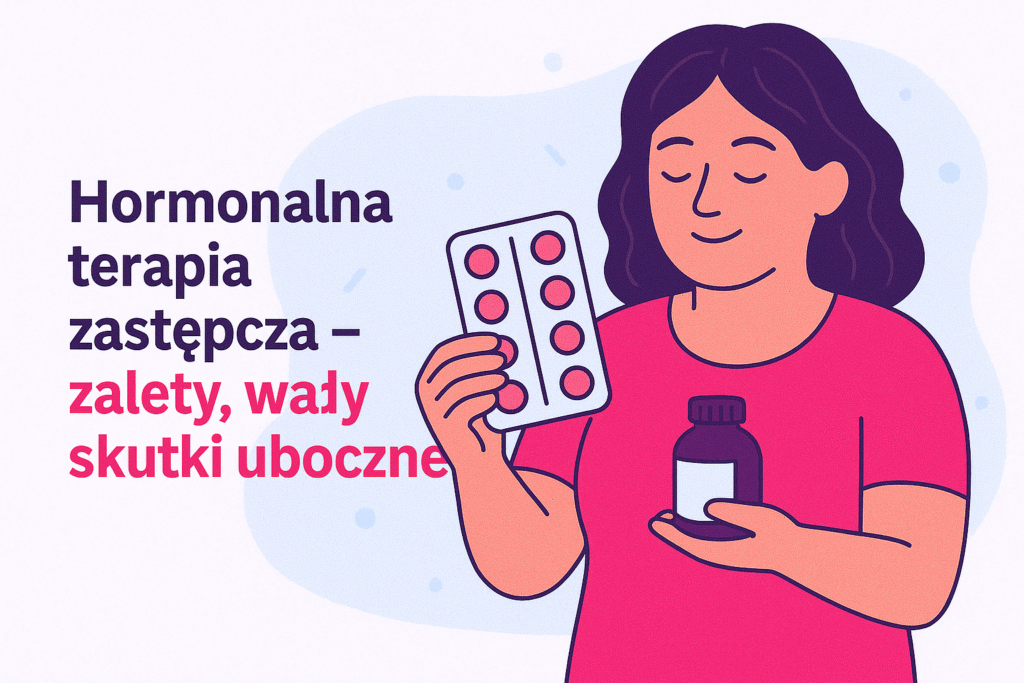Hormone replacement therapy (HRT) is one of the most effective methods for alleviating menopausal symptoms. However, it has been surrounded by controversy and myths, especially following the publication of the well-known WHI study results in 2002. This article reviews the current scientific understanding of HRT: when it should be considered, its benefits and risks, and who can use it safely.
What is hormone replacement therapy?
HRT involves administering estrogens (sometimes combined with progestogens) to women whose natural production of sex hormones has declined due to menopause or surgical removal of the ovaries.
The goals of therapy are:
- To alleviate climacteric symptoms (e.g. hot flashes, vaginal dryness, sleep disturbances)
- To prevent long-term effects of estrogen deficiency (e.g. osteoporosis, lipid disorders)
When should HRT be considered?
Most medical organizations (including the International Menopause Society and the North American Menopause Society) recommend HRT for women with moderate to severe menopausal symptoms that affect quality of life, provided there are no contraindications¹.
The best outcomes are seen when therapy is initiated within 10 years after menopause or before age 60 – this is when the benefit-risk ratio is most favorable².
Forms of HRT
- Oral: tablets containing estrogen or estrogen plus progestogen
- Transdermal: patches, gels – lower risk of thrombosis³
- Vaginal: creams, suppositories – used locally, mainly for vaginal dryness
- Combined estrogen-progestogen therapy: for women with a uterus
- Estrogen-only therapy: for women after hysterectomy
Benefits of HRT
- Significant reduction of menopausal symptoms
- Reduction of hot flashes by up to 80%⁴
- Improved sleep and mood
- Increased vaginal lubrication and better sexual health
- Protection against osteoporosis and fractures
- Estrogens reduce the risk of hip and spine fractures⁵
- Metabolic and vascular benefits (in selected cases)
- Improved lipid profile (↑ HDL, ↓ LDL)
- Early HRT may reduce the risk of coronary heart disease⁶
- Potential protection against type 2 diabetes and Alzheimer’s disease (not definitively confirmed)
Potential risks and side effects
HRT is not risk-free and requires an individualized approach.
- Increased risk of thrombosis and stroke (especially with oral HRT)⁷
- Transdermal forms are safer for women at vascular risk
- Increased risk of breast cancer (with long-term use of combined therapy)
- Risk increases after 5 years of therapy⁸
- Estrogen-only therapy (without progestogen) does not increase breast cancer risk and may even reduce it⁹
- Risk of endometrial cancer (with estrogen-only use in women with a uterus)
- Hence, women with a uterus need combined estrogen-progestogen therapy
- Gastrointestinal issues, breast tenderness, mood changes – usually temporary
Contraindications for HRT
- History or presence of hormone-dependent cancers (e.g. breast, endometrial cancer)
- Thrombosis, pulmonary embolism
- Liver disease
- Undiagnosed vaginal bleeding
- Recent strokes or heart attacks
Alternatives to HRT
- Phytoestrogens and dietary supplements (e.g. soy, red clover, black cohosh)
- Non-hormonal medications (e.g. SSRIs for hot flashes, gabapentin, pregabalin)
- Local therapies without systemic effects (e.g. vaginal estrogen gels)
- Lifestyle changes – diet, physical activity, stress reduction
Summary
HRT can be a highly effective way to improve quality of life during menopause, provided it is individually tailored, started at the right time, and monitored by a healthcare professional. Not every woman needs HRT, but for many it can be a safe and beneficial option.
It is always worth discussing all options with a gynecologist or endocrinologist before making a decision – especially in the presence of chronic conditions.
Przypisy
- North American Menopause Society. Hormone Therapy Position Statement. Menopause. 2022.
- Manson JE et al. Menopausal hormone therapy and health outcomes during the intervention and extended poststopping phases of the Women’s Health Initiative randomized trials. JAMA. 2013.
- Scarabin PY et al. Differential association of oral and transdermal estrogen-replacement therapy with venous thromboembolism risk. Lancet. 2003.
- MacLennan AH et al. Hormone therapy for menopausal symptoms. Cochrane Database Syst Rev. 2004.
- Cauley JA et al. Estrogen replacement therapy and fractures in older women. Ann Intern Med. 1995.
- Rossouw JE et al. Postmenopausal hormone therapy and risk of cardiovascular disease by age and years since menopause. JAMA. 2007.
- Canonico M et al. Hormone therapy and venous thromboembolism among postmenopausal women. Circulation. 2007.
- Chlebowski RT et al. Estrogen plus progestin and breast cancer incidence and mortality in postmenopausal women. JAMA. 2010.
- Anderson GL et al. Conjugated equine estrogen and breast cancer incidence and mortality in postmenopausal women with hysterectomy. JAMA. 2012.

